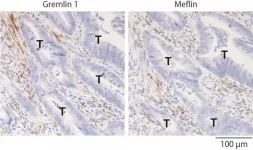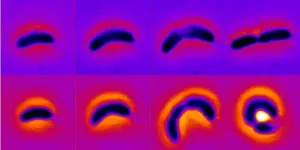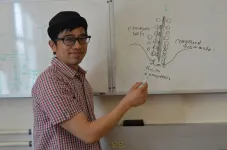Host immune classifier HIC assays may predict treatment response
Research presented at IASLC 2020 World Conference on Lung Cancer Singapore
2021-01-30
(Press-News.org) (Singapore--4:45 p.m. SPT/3:45 a.m. EST January 30, 2021--Using a host immune classifier (HIC) test for patients with non-small cell lung cancer (NSCLC) may provide better predictors of treatment response and improve outcomes, according to research presented today at the International Association for the Study of Lung Cancer's 2020 World Conference on Lung Cancer Singapore.
Immune checkpoint inhibitors have revolutionized cancer care in patients with advanced stage aNSCLC, but better predictors of treatment response are still needed to guide treatment decisions for patients diagnosed with NSCLC, according to Dr. Wallace Akerley, of Huntsman Cancer Institute in Salt Lake City, Utah. HIC (Host Immune Classifier) is a serum proteomic measure of inflammation. Hot implies that the tumor is inflamed.
Researchers from 33 sites enrolled 3,500 patients with NSCLC in a prospective, observational study that assessed the ability of clinical factors and a clinically validated, blood-based, HIC to predict immune checkpoint inhibitor (ICI) therapy outcomes.
Results in a real-world clinical setting, overall survival (OS) of subjects with newly diagnosed aNSCLC did not differ significantly between ICI and ICI+ chemotherapy (median OS (mOS): 9.4 vs. 12.5 months; hazard ratio, 0.80 [95% CI: 0.54-1.19], p = 0.28).
Results demonstrated that subjects receiving ICI indicated that HIC (HIC defined in title, better performance status (PS) and younger age, but not high PD-L1 expression (either 50% or 90% cutoff) were significantly associated with longer OS. When adjusted for covariates in a multi-variate analysis, HIC and age remained significant predictors of OS (p = 0.0006 and p = 0.005), while PS did not (p = 0.40).
"The HIC test provides clinically meaningful information in addition to currently used clinical factors to potentially help guide immunotherapy treatment decisions for patients with newly diagnosed NSCLC," said Dr. Block.
INFORMATION:
About the IASLC:
The International Association for the Study of Lung Cancer (IASLC) is the only global organization dedicated solely to the study of lung cancer and other thoracic malignancies. Founded in 1974, the association's membership includes nearly 7,500 lung cancer specialists across all disciplines in over 100 countries, forming a global network working together to conquer lung and thoracic cancers worldwide. The association also publishes the Journal of Thoracic Oncology, the primary educational and informational publication for topics relevant to the prevention, detection, diagnosis, and treatment of all thoracic malignancies. Visit http://www.iaslc.org for more information.
About the WCLC:
The WCLC is the world's largest meeting dedicated to lung cancer and other thoracic malignancies, attracting nearly 7,500 researchers, physicians and specialists from more than 100 countries. The goal is to increase awareness, collaboration and understanding of lung cancer, and to help participants implement the latest developments across the globe. The conference will cover a wide range of disciplines and unveil several research studies and clinical trial results. For more information, visit wclc2020.iaslc.org.
ELSE PRESS RELEASES FROM THIS DATE:
2021-01-30
Nagoya University researchers and colleagues have revealed that colorectal cancer tissues contain at least two types of fibroblasts (a type of cells found in connective tissue), namely, cancer-promoting fibroblasts and cancer-restraining fibroblasts, and that the balance between them is largely involved in the progression of colorectal cancer. Their findings, recently published in the journal Gastroenterology, suggest that artificially altering the balance between the two types of cells could curb the spread of colorectal cancer tumors, which may become an effective strategy for preventing cancer progression.
Cancer tissues comprise both cancer cells and non-malignant cells such as fibroblasts. Previous studies have suggested that the proliferation of fibroblasts ...
2021-01-30
(Singapore--January 29, 2021 9:35 a.m. SPT/January 28, 2021 8:35 p.m. EST)--Two radiation oncology trials presented at the IALSC World Conference on Lung Cancer Singapore highlight how some researchers are exploring use of higher radiation boost doses to only PET-positive regions in locally-advanced non-small cell lung cancer (NSCLC). A previous large RTOG phase III trial revealed that the unform delivery of a high dose to the entire tumor led to poorer survival.
In one study, Prof. Feng-Ming (Spring) Kong, Case Western Reserve University School of Medicine, in Cleveland, Ohio presented the results of a multicenter trial which aimed to ...
2021-01-30
(Singapore Embargoed for 7:23pm EST on January 29, 2021 to coincide with publication in the Journal of Clinical Oncology) -- Adding ipilimumab to pembrolizumab does not improve efficacy and is associated with greater toxicity than pembrolizumab alone as first-line therapy for metastatic non-small cell lung cancer (NSCLC) for patients with a PD-L1 tumor proportion score of greater than or equal to 50% and no targetable EGFR or ALK aberrations, according to research presented today at the International Association for the Study of Lung Cancer's World Conference on Lung Cancer.
The research was presented ...
2021-01-29
New research led by Carnegie Mellon University Assistant Professor of Physics Shiladitya Banerjee demonstrates how certain types of bacteria can adapt to long-term exposure to antibiotics by changing their shape. The work was published this month in the journal Nature Physics.
Adaptation is a fundamental biological process driving organisms to change their traits and behavior to better fit their environment, whether it be the famed diversity of finches observed by pioneering biologist Charles Darwin or the many varieties of bacteria that humans coexist with. While antibiotics have long helped people prevent and cure bacterial infections, many species of bacteria have increasingly been able to adapt to ...
2021-01-29
School closures during COVID-19 have decreased access to school meals, which is likely to increase the risk for food insecurity among children in Maryland, according to a new report issued by researchers at the University of Maryland School of Medicine (UMSOM). The number of meals served to school-age children during the first three months of the pandemic dropped by 58 percent, compared to the number of free or reduced-price meals served the previous spring. As a result, thousands of children across the state were placed at increased risk of food insecurity, with many likely experiencing the health ramifications ...
2021-01-29
Boulder, Colo., USA: GSA's dynamic online journal, Geosphere, posts articles online regularly. Topics for articles posted for Geosphere this month include feldspar recycling in Yosemite National Park; the Ragged Mountain Fault, Alaska; the Khao Khwang Fold and Thrust Belt, Thailand; the northern Sierra Nevada; and the Queen Charlotte Fault.
Feldspar recycling across magma mush bodies during the voluminous Half Dome and Cathedral Peak stages of the Tuolumne intrusive complex, Yosemite National Park, California, USA
Louis F. Oppenheim; Valbone Memeti; Calvin G. Barnes; Melissa Chambers; Joachim Krause ...
Abstract: Incremental pluton growth can produce sheeted complexes with no magma-magma interaction or large, dynamic magma bodies communicating via crystal and melt exchanges, depending ...
2021-01-29
Washington, DC — Blood pressure that remains elevated over of time — known as chronic hypertension — has been linked to heart disease, which is the leading cause of death in the United States. Recent research has shown that persistent high blood pressure may also increase the risk for stroke and overall mortality. Yet, only about 1 in 4 adults with chronic hypertension have their condition under control, according to the Centers for Disease Control and Prevention.
In a new study to be presented today at the Society for Maternal-Fetal Medicine's (SMFM) annual meeting, The Pregnancy Meeting™, researchers from the University of Pittsburgh will unveil findings that suggest that women who develop high blood pressure during pregnancy and who continue ...
2021-01-29
News reports indicate COVID-19 vaccines are not getting out soon enough nor in adequate supplies to most regions, but there may be a larger underlying problem than shortages. A University of California, Davis, study found that more than a third of people nationwide are either unlikely or at least hesitant to get a COVID-19 vaccine when it becomes available to them.
The results are from public polling of more than 800 English-speaking adults nationwide in a study published online earlier this month in the journal Vaccine.
"Our research indicates that vaccine uptake will be suboptimal ... with 14.8 percent of respondents being unlikely to get vaccinated ...
2021-01-29
WOODS HOLE, Mass. -- The most powerful substance in the human brain for neuronal communication is glutamate. It is by far the most abundant, and it's implicated in all kinds of operations. Among the most amazing is the slow restructuring of neural networks due to learning and memory acquisition, a process called synaptic plasticity. Glutamate is also of deep clinical interest: After stroke or brain injury and in neurodegenerative disease, glutamate can accumulate to toxic levels outside of neurons and damage or kill them.
Shigeki Watanabe of Johns Hopkins University School of Medicine, a familiar face at the Marine Biological Laboratory (MBL) as a faculty member and researcher, is hot on the ...
2021-01-29
RIVERSIDE, Calif. -- When we step on the car brake upon seeing a red traffic light ahead, a sequence of events unfolds in the brain at lightning speed.
The image of the traffic light is transferred from our eyes to the visual cortex, which, in turn, communicates to the premotor cortex -- a section of the brain involved in preparing and executing limb movements. A signal is then sent to our foot to step on the brake. However, brain region that helps the body go from "seeing" to "stepping" is still a mystery, frustrating neuroscientists and psychologists.
To unpack this "black box," a team of neuroscientists at the University of California, Riverside, has ...
LAST 30 PRESS RELEASES:
[Press-News.org] Host immune classifier HIC assays may predict treatment response
Research presented at IASLC 2020 World Conference on Lung Cancer Singapore




